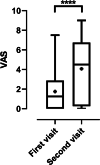Long-term impact of olfactory dysfunction on daily life
- PMID: 33084955
- PMCID: PMC8500863
- DOI: 10.1007/s00508-020-01751-5
Long-term impact of olfactory dysfunction on daily life
Abstract
Background: Olfactory dysfunction (OD) is common in the general population, affects the quality of life (QoL), and is suspected to cause depression. Long-term outcome data are lacking and there is a need to improve patient counselling regarding prognosis. We aimed to assess subjective long-term recovery rates, the QoL, and mood disturbance in a group of 65 patients, who were affected with OD.
Methods: Out of 325 patients treated for OD between 2003 and 2009 at a smell and taste clinic, 65 patients were included for a follow-up after an average of 8.6 years. A total of 28 patients answered questionnaires only and 37 patients were provided with an additional smell identification test. Among others, questionnaires included a short form of the World Health Organization quality of life questionnaire (WHOQOL-BREF) and the Beck's depression inventory.
Results: In the long run, subjective improvement was stated in 33.8% of all patients, with the highest rate of 42.3% in patients with postinfectious OD. The subjective rating of olfactory function on a visual analogue scale was significantly higher at study follow-up compared to first clinical contact (median 1.25 vs. 4.5; U = 469.5, p = 0.001), as were mean identification scores (6.0 ± 3.0 vs. 8.0 ± 4.0, t(18) = 2.51, p = 0.021). The QoL in general was considered reduced in 40% of all patients at follow-up. Furthermore, participants exhibited only minor, if any, depressive symptoms.
Conclusion: Despite negative effects of OD on certain activities in daily life, such as cooking, detecting spoiled food, or personal hygiene, it seems that the patients included in this study adapted to the OD in the long-term. The current findings should aid clinicians in patient counselling.
Keywords: Anosmia; Hyposmia; Prognosis; Quality of life; Smell.
© 2020. The Author(s).
Conflict of interest statement
A. B. Auinger, G. Besser, D. T. Liu, B. Renner, and C. A. Mueller declare that there is no conflict of interest.
Figures



Similar articles
-
Depression Symptoms and Olfactory-related Quality of Life.Laryngoscope. 2022 Sep;132(9):1829-1834. doi: 10.1002/lary.30122. Epub 2022 Mar 30. Laryngoscope. 2022. PMID: 35353380 Free PMC article.
-
Self-perceived Taste and Flavor Perception: Associations With Quality of Life in Patients With Olfactory Loss.Otolaryngol Head Neck Surg. 2021 Jun;164(6):1330-1336. doi: 10.1177/0194599820965242. Epub 2020 Oct 13. Otolaryngol Head Neck Surg. 2021. PMID: 33048605
-
Olfaction and quality of life in patients with nasal septal deviation treated with septoplasty.Am J Otolaryngol. 2019 Sep-Oct;40(5):747-754. doi: 10.1016/j.amjoto.2019.07.008. Epub 2019 Jul 16. Am J Otolaryngol. 2019. PMID: 31345588
-
Olfactory Dysfunction: A Highly Prevalent Symptom of COVID-19 With Public Health Significance.Otolaryngol Head Neck Surg. 2020 Jul;163(1):12-15. doi: 10.1177/0194599820926464. Epub 2020 May 5. Otolaryngol Head Neck Surg. 2020. PMID: 32366160 Review.
-
The Prevalence of Olfactory Dysfunction in the General Population: A Systematic Review and Meta-analysis.Am J Rhinol Allergy. 2021 Mar;35(2):195-205. doi: 10.1177/1945892420946254. Epub 2020 Aug 3. Am J Rhinol Allergy. 2021. PMID: 32746612
Cited by
-
Chemosensory Functions After Glossectomy-A Cross-Sectional Pilot Study.Laryngoscope. 2023 Feb;133(2):375-382. doi: 10.1002/lary.30454. Epub 2022 Oct 18. Laryngoscope. 2023. PMID: 36254878 Free PMC article.
-
The impact of olfactory loss on quality of life: a 2025 review.Chem Senses. 2025 Jan 22;50:bjaf023. doi: 10.1093/chemse/bjaf023. Chem Senses. 2025. PMID: 40719006 Free PMC article.
-
Olfaction and anosmia: From ancient times to COVID-19.J Neurol Sci. 2021 Jun 15;425:117433. doi: 10.1016/j.jns.2021.117433. Epub 2021 Apr 3. J Neurol Sci. 2021. PMID: 33848701 Free PMC article. Review.
-
Understanding the olfactory role in post-COVID cognitive and neuropsychiatric manifestations.Front Psychol. 2024 May 27;15:1407887. doi: 10.3389/fpsyg.2024.1407887. eCollection 2024. Front Psychol. 2024. PMID: 38860043 Free PMC article.
-
Viral Etiologies and Histopathological Features of Olfactory Dysfunction: A Systematic Review.Health Sci Rep. 2025 Jun 18;8(6):e70917. doi: 10.1002/hsr2.70917. eCollection 2025 Jun. Health Sci Rep. 2025. PMID: 40535522 Free PMC article. Review.
References
MeSH terms
LinkOut - more resources
Full Text Sources
Medical

